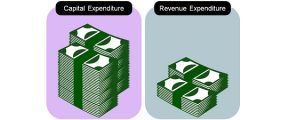 In general, two types of receipts occur during the course of business. Capital Receipt is described as the money brought to the business from non-operating sources like proceeds from the sale of long-term assets and capital brought by the proprietor. These receipts do not affect the company’s profit or loss.
In general, two types of receipts occur during the course of business. Capital Receipt is described as the money brought to the business from non-operating sources like proceeds from the sale of long-term assets and capital brought by the proprietor. These receipts do not affect the company’s profit or loss.
In contrast, revenue receipts are the result of the firm’s routine activities during the financial year, which include sales, commission, and interest on investment. These receipts affect the profit and loss of the enterprise, i.e. receipts from operational sources.
The difference between capital and revenue receipts is important for the purpose of determination of income and taxation.
Content: Capital Receipt Vs Revenue Receipt
- Comparison Chart
- What is Capital Receipt?
- What is a Revenue Receipt?
- Key Differences
- Points to Note
- Conclusion
Comparison Chart
| Basis for Comparison | Capital Receipt | Revenue Receipt |
|---|---|---|
| Meaning | Capital Receipt is the amount which a company receives by selling the fixed assets or loan taken from the bank. | Revenue Receipt is the amount which a company receives out of proceeds from selling goods and services. |
| Appears in | Balance Sheet | Trading and Profit & Loss Account |
| Nature | Non-Recurring | Recurring |
| When are they received? | They are not received in the course of normal business activities. | They are received in the course of normal business activities. |
| Year of Benefit | The company can derive benefits in the current year as well as in future years. | The company receives benefits in the current year only. |
| Capitalization | It will be capitalised. | It will not be capitalized. |
| Need | Improving the working capacity and business expansion. | Maintaining the existing working capacity of the business. |
| Matching concept | Not matched with the capital expenditure. | Matched with the revenue expenditure to know the profit or loss for the financial year. |
| Amount | Generally Substantial | Comparatively Smaller |
| Creation of liability or reduction of asset | They either create liability or reduce the assets of the government | They neither create liability nor reduce the assets of the government. |
| Future obligation | In some cases, there is a future obligation to return the amount. | There is no future obligation to return the amount. |
What is Capital Receipt?
Capital Receipts are the receipts that occur due to casual or non-recurring transactions and not because of the ordinary operation of the business. We consider a receipt as a capital receipt when the proprietor of the business contributes towards the business’s capital. It does not have any impact on the company’s profit or losses during the financial year.
Any receipt obtained for buying fixed assets or making a permanent improvement in the existing assets so as to increase the profit-earning capacity is a capital receipt. 
Features of Capital Receipts
- Capital Receipts do not arise during the ordinary course of business
- They are of non-recurring nature
- Appear in the Balance Sheet
- Creates liability
Examples
- Capital contributed by members
- Loans Raised
- Legacies
- Donations for specific purposes
- Money received by issuing share capital
- Compensation for the surrender of certain rights
- Proceeds from selling fixed assets, even if it is received in instalment
- Compensation for premature termination of the agreement
- Government grants
- Life membership fees
- Receipts of proceeds of a LIC policy when it matures.
- Receipt of insurance money over original cost, which is destroyed in an accident
- Sale of scrap
- Receipt of premium on issue of shares
Accounting Treatment
Capital Receipts are credited to the concerned account. Further, they appear on the liabilities side of the Balance sheet.
Also Read: Difference Between Capital and Revenue Expenditure
What is a Revenue Receipt?
We consider a receipt as a revenue receipt when customers pay money for the goods provided or services rendered in the normal course of business. In short, these receipts arise from the core business activities. So, they are a part of normal business operations, which is why they occur again and again. However, its benefit can be enjoyed only in the current accounting year as its effect is short-term.
Revenue receipts increase the company’s profits and decrease the losses of the company. It must match the revenue expenses of the company so as to determine the profit of the period.
Features of Revenue Receipts
- These receipts are of recurring nature.
- They result from normal business activities.
- Such receipts are for general purposes.
- They appear in the profit and loss account for calculating the financial year’s income. This means these receipts are matched against the revenue expenses for the period to determine the profit earned or loss sustained by the business.
- Revenue receipts do not result in the creation of liabilities.
Examples
- Proceeds from the sale of goods
- Entrance fee
- Locker Rent
- Sale of old newspaper
- Donations of general nature
- Discounts and commissions received
- Annual subscriptions
- The amount received from debtors.
- Bad debts recovered
- Interest in investments received from UTI
- Receipt of compensation on account of loss of stock in trade
- Receipt in substitution of income
- Compensation for loss of profit.
- Money received from the government for stock in trade was destroyed due to civil disturbances.
- Subsidy or cash assistance which the company receives for export promotion scheme.
- Income from wasting assets
- Profit on sale of shares if MOA authorizes it.
- Receipt on the transfer of floating assets
Accounting treatment
Revenue Receipts are entered in the nominal accounts. Further, they are taken to trading and profit and loss accounts at the end of each accounting period.
Also Read: Difference Between Expenses and Expenditure
Key Differences Between Capital Receipt and Revenue Receipt
- Capital Receipts arise from two main sources: First, from the investment in the business by the proprietor, partner or shareholder, be it for commencing the business or expanding it. Next, the money is received on account of loans, mortgages, debentures, etc. On the other hand, revenue receipts are nothing but the profit earned from the business operations.
- The use of capital receipts is to purchase fixed assets or make permanent improvements to an asset in order to increase the earning capacity. Conversely, the use of revenue receipts is to meet day-to-day expenses such as purchasing goods, payment of freight, etc
- Revenue Receipt appears on the credit side of the profit and loss account as an income for the year. In contrast, capital receipts form part of the balance sheet. It appears on the liabilities side of the balance sheet.
- Revenue Receipt has a short-term effect. This is because the company can derive its benefits within one accounting period. As against, Capital Receipt has a long-term effect. The firm can derive benefits for many years to come.
- While a revenue expenditure repeatedly arises, as it is recurring and regular. Capital Receipt does not arise again and again. It is not a recurring receipt.
- Revenue Receipt has no effect on the increase or decrease in the value of an asset or liability. Conversely, Capital Receipt either decreases the asset’s value or increases the liability’s value.
Example
The amount received from the sale of fixed assets is a capital receipt. It will increase the cash, but at the same time, it will decrease the value of the fixed asset. Similarly, if the company has taken a bank loan, it will increase the cash but also increase the liability.
- While the amount received as fixed capital is a capital receipt, the amount received as circulating capital is a revenue receipt.
- Receipt, in substitution of a source of income, is treated as capital receipt. For instance, an employee’s compensation on the termination of his service is a capital receipt. As against, a receipt in substitution of income is treated as a revenue receipt. For instance, when an employee receives a reward for his good performance, it is a revenue receipt.
Points to Note
- The magnitude of the receipt does not matter because a receipt of ₹ 1 lakh can be a revenue receipt, and a receipt of ₹ 100 can be a capital receipt.
- Any receipt occuring by surrendering the rights is a capital receipt. Example: The pension that an employee receives is a revenue receipt. However, if a person withdraws pension in lumpsum, it is a capital receipt. This is because the person surrenders his/her right to receive the pension monthly. So, the sum received in nature of compensation for the loss of future profits is a revenue receipt.
- While proceeds from selling an investment is a capital receipt, proceeds from selling stock in trade is a revenue receipt. Example: The amount received from the sale of goods produced is a revenue receipt. However, the amount received from the sale of the machine which is used for producing the goods is a capital receipt.
- Withdrawing an amount in lumpsum does not make a revenue receipt into a capital receipt.
- Irrespective of whether the receipt is voluntary or non-voluntary, it does not determine the nature, i.e. whether it is capital or revenue.
- The nature of receipt depends upon the person receiving the money and not on the source who makes the payment. For instance, the payment of interest from the capital by the firm is a capital expenditure. However, it is a revenue receipt for the person who receives it.
Conclusion
All in all, capital receipts are not available for the distribution of profits. However, the company can use revenue receipts to distribute the profits.






Anchal Bansal says
Nice.
Shubham says
Sooooooo HELPFUL
Swastik das says
Nice answer
Gaurav Kshirsagar says
Great
Babatunde Ridwan Olamilekan says
Very Good